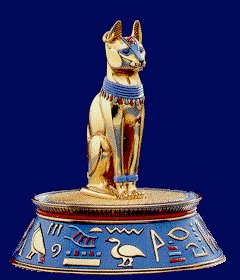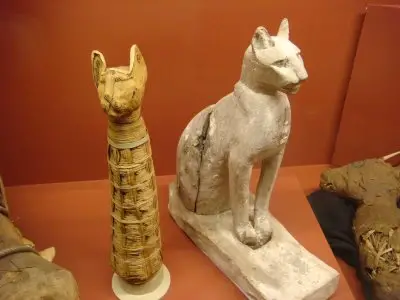We know that animals were worshipped by ancient Egyptians. Feline reverence had a noteworthy significance in their religious life. The Ancient Egyptian cats were domesticated in Egypt, probably around 2000 B.C.
There was one word for cat-and that was miu or mii, meaning “he or she who mews.” The fact that armies were even sent out to recapture cats from foreign lands tells us how much they valued these affectionate animals.

Cats were respected and regarded as sacred. These lovable pets fascinated the Egyptians. Initially, they were used to ward off snakes and slowly they began to be worshipped as deities. Whoever killed a cat was condemned to death in the country. A household would go into mourning when a cat died. Children, especially the girls were often named after cats.
The goddess Mafdet who symbolized of justice and execution was a lion-headed goddess. The cat goddess Bastet eventually replaced the cult of Mafdet, and Bast’s image softened over time and she became the deity representing protection, fertility, and motherhood.
Head of Ancient Egyptian Cats

Bastet was often depicted as having the body of a woman and the head of a domestic cat. She was associated with the Eye of Ra, acting within the sun god’s power.
Cats were mummified after death as humans. The discovery of a large tomb outside the town of Beni Hasan had eighty thousand cat mummies, dating to 1000-2000 BCE. Mummified cats were offered to the cat goddess. Bubastis contains the remains of over 300,000 cat mummies. In the tombs of the cats were set bowls of milk along with mice and rats.
The two native Egyptian cat species were the Jungle Cat and the African Wildcat. The Wildcat was largely domesticated; the jungle cat was not as docile and was probably not especially helpful in the initial phases of domestication.
Integral part of Egypt Family
During the New Kingdom, there were many tomb scenes that started showing cats as part of everyday life. The ancient Egyptians took their cats on hunting excursions instead of dogs. Another very common scene in tomb paintings was a cat seated on a woman’s chair, showing that the cat had become an integral part of the ancient Egyptian family life.
Over periods of time, cat statuettes were made intended for shrines or funerary purposes. There was a Bastet festival conducted every year in the month of October to please the god Bastet. There were gold cats on intricate bracelets, small golden cat pendants, cats amulets made of soapstone for necklaces and rings.
Women made up their faces holding mirrors with cats on the wooden handles and on their cosmetic pots. The best part was that ordinary people could enjoy the protection of the cat goddess through their amulets on their clothing or around their necks or in their earlobes. Ancient Egyptian Cats even figured in dream interpretation. There were even laws prohibiting the exportation of cats.
